The evolution of the historic role of Grosse Île
Grosse Île and the Irish Memorial National Historic Site
Quarantine and public health: the changing role of Grosse Île
by André Sévigny, Historian, September 1995
From the time it opened in 1832 to its closure in 1937, the human quarantine station at Grosse Île was responsible for public health at the Laurentian gateway to Canada. Over the years, a wide range of events marked the history of this station. Some, however, had a greater impact on its evolution than others.
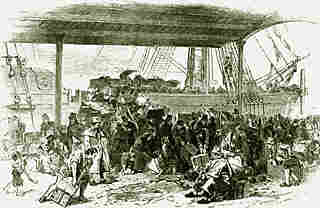 Major epidemics 1
Major epidemics 1© McGill University / ILN / DRBSC, 1850
The Grosse Île quarantine station came into being in a very special context. After the Napoleonic Wars ended in 1815, a growing number of people left the British Isles, particularly Ireland and Scotland, to make new lives for themselves in North America. Around 1830, an average of 30 000 immigrants arrived annually in Québec, the main port of entry to Canada. Approximately two-thirds of these newcomers were from Ireland. This unprecedented immigration to the St. Lawrence Valley took place at a time when major epidemics were raging on the European continent as well as in Great Britain; the second cholera pandemic (1829-1837) hit England in 1831-1832. The disease was carried to America and Canada by migrants, many of whom were Irish. People from Ireland often embarked for the New World from English ports.
 Major epidemics 2
Major epidemics 2© McGill University / ILN / DRBSC, 1847
Reports that people with the dreaded disease were about to arrive via the St. Lawrence River immediately prompted the colonial authorities to set up a veritable quarantine station on Grosse Île, an island located in the middle of the river, 48 km downstream from Québec. The station had to deal with another cholera outbreak in 1834, before battling an even more deadly typhus epidemic in 1847-1848. Once again, the victims of the latter epidemic were mainly Irish immigrants. At the time, an unprecedented number of people were fleeing the terrible potato famine in Ireland: some 100 000 sailed for Québec in 1847. This period of virulent epidemics came to an end only after another outbreak of cholera in 1854.
Certain other factors also marked the first few decades of the quarantine station's history. First, the Canadian government did not really have a say in this so-called British emigration, which was managed by the colonial authorities. Second, the operation of the station was characterized by haste, improvisation, and trial and error, without any real understanding of the causes, spread and treatment of infectious diseases. Moreover, the island's facilities were ill equipped to accommodate and safely treat large numbers of immigrants, especially when they were sick. These problems, compounded by the crowded, unsanitary conditions in which people lived during the long ocean crossing, soon created an explosive, uncontrollable situation. It is easy to understand why thousands of Irish immigrants died at Grosse Île in 1847.
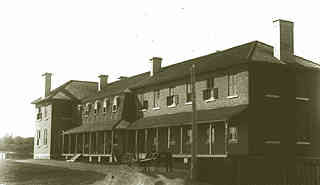 Brick hospital, built in 1881
Brick hospital, built in 1881© D.A. McLaughlin / NAC / PA-148819
History and legend soon perpetuated the memory of this dark period in the history of the quarantine station. However, they reflected only part of the story. Other less prominent events also took place at Grosse Île, in connection, notably, with the long search for efficient, modern ways of welcoming immigrants and treating infectious diseases.
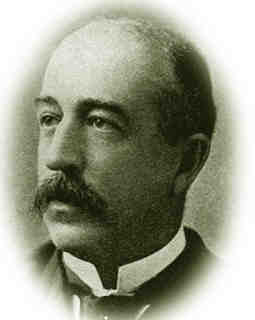 Doctor Frederick Motizambert
Doctor Frederick Motizambert© Who's who in Canada, 1922 Edition
In the 1850s, and especially as of Confederation in 1867, the Canadian government formulated a comprehensive policy on immigration and settlement, requiring the establishment of a reliable, efficient quarantine station. Memories of the fairly recent catastrophes were still fresh in people's minds, and a number of essential lessons had been learned. Dr. Frederick Montizambert, a bacteriologist, was in charge of relaunching operations at the Grosse Île quarantine station, where he acted as medical superintendent from 1869 to 1899.
Montizambert first ensured that the island's facilities were laid out so as to prevent sick immigrants from coming into contact with healthy travellers or people under observation. Over the years, as prevailing economic conditions, immigration trends and available funding gave occasion, he renewed the station's facilities, which included hospitals, travellers' accommodations, workers' houses, chapels and so forth. He also ensured that new quarantine regulations were adopted to eliminate loopholes and laxity.
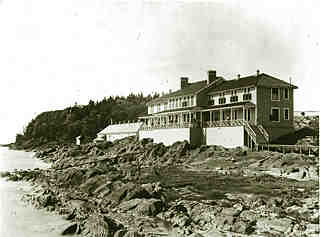 Second-class hotel, built in 1893
Second-class hotel, built in 1893© D.A. McLaughlin / NAC / C-79029
Montizambert was well acquainted with the major scientific and medical discoveries relating to the diagnosis, treatment and even prevention of infectious diseases. He therefore imposed increasingly stringent and effective controls on ships and immigrants: vessels and luggage were inspected and disinfected, while passengers were examined and vaccinated; medical analyses were also conducted in laboratories. Montizambert took these steps in response to new conditions stemming from the globalization of immigration, the growing number of infectious diseases and the speed of ocean travel on steamships.
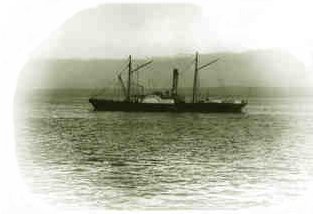 Steamer "Druid"
Steamer "Druid"© D.A. McLaughlin / NAC / PA-148821
In fact, the proliferation of steamships and their increasingly comfortable facilities were what prompted the superintendent to modernize the structures for welcoming and accommodating immigrants at Grosse Île. From the late 19th century to World War I, modern first-, second- and third-class hotels were placed at the disposal of travellers who had crossed the Atlantic. Montizambert thus succeeded in meeting the formidable challenge of giving the concept of public health new meaning in the context of immigration, while providing immigrants with efficient service and comfortable facilities.
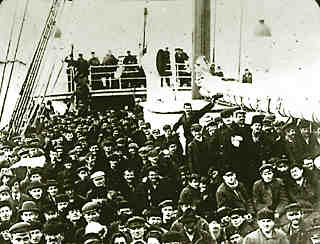 Immigrants arriving in Canada, around 1900
Immigrants arriving in Canada, around 1900© NAC / PA-30607
With its modern facilities and internationally renowned service, Grosse Île seemed to have a promising future, especially given the unprecedented immigration levels at the beginning of the century in Québec: 100 000 newcomers arrived in 1910, 170 000 in 1912 and 225 000 in 1914. Plans were even made to erect a vast, modern hospital complex at the quarantine station. However, exceptional circumstances prevented the construction project from being implemented.
The First World War (1914-1918) and the Great Depression (1929) drastically reduced the number of people immigrating to Canada. Moreover, since the turn of the century, tremendous progress had been made with regard to medical research in microbiology and contagious diseases, and the hospital on Grosse Île now treated almost exclusively minor childhood infections such as diphtheria, chicken pox and measles. As well, according to international health agreements, people infected with these diseases no longer had to be quarantined. Moreover, serious infections such as cholera, typhus and smallpox could be successfully treated at the Parc Savard Hospital in Québec, founded in 1907. The quarantine station on Grosse Île was closed in 1937.
The history of the quarantine station might be viewed as a horrible tragedy, given that its first chapter ended in disaster for thousands of Irish people. Nevertheless, this sad tale had a happy ending, marked by the alleviation of sickness and despair. In the final analysis, the death and suffering of many of the immigrants who stopped at Grosse Île were not in vain.
- Date modified :